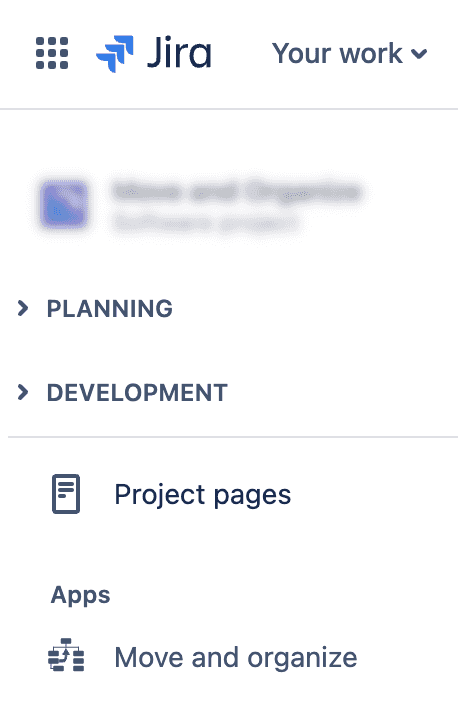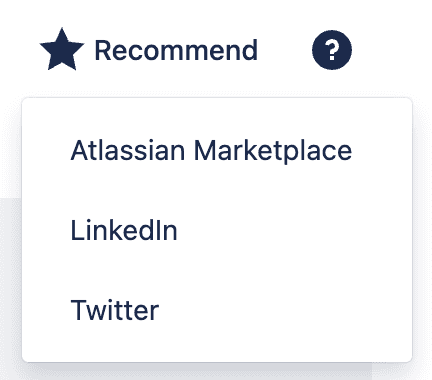Overview
Starting Move and Organize

You start Move and Organize by navigating to the project in Jira you want to work on. Once installed successfully, Move and Organize is found as one of the menu options in the left-hand Project sidebar.
There is also a first time setup guide available through the Top menu Apps → Move and Organize option. The guide will automatically help you identify if any of your projects may require setup (see next section on Advanced Roadmaps), and allow you to directly start Move and Organize for a project you select.
Setup for Advanced Roadmaps (Multi-Level)
If you have a Jira Premium subscription, you can easily setup Move and Organize to work with your Advanced Roadmaps projects and additional hierarchy levels beyond Epics.
Enable the issuetype levels to be recognized by Move and Organize in the Jira Top Toolbar → Settings → Issues → Issue types screen. For these layers, append to the Issue description the level (as it has been configured in the Advanced Roadmaps issuetype configuration) encapsulated by brackets.

Tips and tricks - Move and Organize is a native integration and fully backwards-compatible with Atlassian Jira - any changes made by Move and Organize is also recognized by Advanced Roadmaps.
Workspace

Move and Organize consist of these key components:
- Toolbar - The toolbar shows the current status of any task requests operating in the background, as well as all the action buttons and selection options
- Workspace - This is the main working area and shows the full tree of your project. It is zoomable and scrollable using your mouse, touchpad and useful keyboard shortcuts
- Issue nodes - Inside the workspace, existing issues in the project are shown as nodes in the tree
- Create nodes - Inside the workspace, create nodes are available to allow for new issues to be created at this location in the tree
Issue Node


Issues nodes come with various combinations of action buttons depending on its state, your project permissions and the hierarchy level in which it resides.
Issue nodes consist of these key components:
- Description - The upper half of the node primarily contain the issue description. Clicking on the description will allow you to modify it
- Field - The bottom left shows information about and allows changes to be made to the currently configured issue field
- Expand/Collapse button - Clicking the Expand/Collapse button will show/hide all its children
- Add button - If the node does not yet have any children, clicking the Add button will show a create node to add a new issue with this node as parent
- Issue link - Link to the detailed issue page
- Remove button - Clicking the Remove button will remove the issue (and if you choose to also its children, if any)
Permissions - Depending on your project permissions, not all of the fields and actions above are editable or actionable. For instance, if you do not have Edit permissions, the issue description and field will be read-only. If you do not have Delete permissions the Remove button will not be shown.
Create Node


Create nodes are shown as inactive (grey background) in tree locations where new issues may be created. If you click on one, it will enable editing mode where you can input the issue description and type for the new issue you are creating.
Tips and tricks - Use the Enter key to create the new issue directly using the keyboard. Multiple issues can be entered in sequence while repeatly typing in the new descriptions and using the Enter key. Move and Organize will automatically scroll the workspace viewport to keep the create node in view and focus to allow you to keep editing with speed.
Toolbar and Status
Status Indicator
The status indicator show you the number of active background tasks (these are actions Move and Organize are performing for you, communicating with your Atlassian cloud instance).

Idle mode

Busy mode

Critical mode
Note - Never close Move and Organize while in Critical mode. Wait for any critical tasks to complete and the status indicator moves to Idle or Busy mode first, to safely exit the page.
Field Configuration
The show field configuration allow you to configure which field should be shown at the bottom left corner of each node.

Filter Configuration
The filter configuration allow you to select which field and value to search for within the tree. Matched nodes will be highlighted in purple colour within the tree.

The filtering function will automatically minimize the tree to only show branches that contain matches.
Note - As the filtering function minimizes the tree, it will continue to show nodes that have not yet been loaded to help indicate there could potentially be matches at lower levels of this branch.
Action Buttons


The following generic actions are available:
- Give feedback - If you encounter any bugs or issues with Move and Organize, or would like to suggest a new feature or capability that you think would be useful, this section provides direct e-mail access to us so that we can assist you
- Recommend - Links to recommend Move and Organize through various services (we hope you like it!)
- Help - Link to the Move and Organize quick guide (this document)
Navigation and Handling
Keyboard Operation
Overview

There are a number of keyboard shortcuts setup to help you make use of Move and Organize with efficiency:
- Letter keys - A cluster of keys easily accessible by the left hand is intended as the primary means for navigating within the full workspace
- Navigation keys - Additional keys for navigating within the full workspace
- Arrow keys - Used for navigating within the local area
- Control keys - Used for selecting/deselecting nodes and other special functions
Dragging
Cancel an on-going drag operation
Selecting Issues
Select or deselect a node
This key works in combination with the mouse, press and hold the Ctrl (or ⌘ on macOS) key while clicking the mouse on a node to add or remove it from the current selection
Select a range of nodes
This key works in combination with the mouse, press and hold the Shift key while clicking the mouse on a node to select a new range
Note - Selecting multiple issues within a range work within the same hierarchy level and when all the nodes have the same parent node
Scrolling
Scroll one page up
Scroll one page down
Scroll one page left
Scroll one page right
Scroll one node up
Scroll one node down
Scroll one node left
Scroll one node right
Scroll to the far left
Scroll to the far right
Scroll to center on project root
Mouse and Touchpad Operation
Overview
Move and Organize make use of click, drag and scroll events to enable you to work with ease with your Jira project.
Mouse and Touchpad devices are both supported - this includes supports for Mouse scroll wheels and swiping left/right and up/down to perform scrolling within the workspace area (finger gestures may based on your system setup, so it will not be described here).
Dragging and Scrolling
When you start to drag a selection, you will find that the border around the workspace changes. A wide, dark grey gradient pops up along the four edges of the workspace. This is the Scroll Border - it allows you to automatically keep scrolling in the direction you desire while dragging. You start this scrolling by moving the mouse cursor within the border area.

The scroll border features a dark grey gradient to help visually indicate the speed of scrolling that will take place depending on where your place your mouse cursor.
Tips and tricks - Keyboard shortcuts may still be used in combination with the scroll border for even faster/more precise scrolling and orientation.
Expanding/Collapsing Issues

Clicking the Expand/Collapse button (located at the bottom centre of issue nodes) will expand or collapse the tree accordingly. Any child nodes that have not yet been loaded from the Atlassian cloud instance will be automatically loaded in the background.
Dragging - While dragging, hovering over a node that is not currently expanded will trigger it to be expanded automatically, and also trigger an operation in the background to load any corresponding child nodes. This allows you to continue navigating further down the hierarchy tree efficiently without stopping.
Actions and Operations
Creating Issues

After clicking the Add button within a node or a Create node in a specific tree location, Editing mode allows you to directly enter the description of the new issue you are creating.

Clicking the bottom left issuetype icon allows you to change the issuetype (if this hierarchy level have no other options available, the dialog will show up blank). If you want to abort the selection, just click outside the dialog box and it will close.
Use the Enter key or click the Check button to create the new issue. Click the Cross button to abort.
Selecting Issues
Multiple nodes may be selected for a Move operation, including issues at different hierarchy levels.

In order to select multiple nodes, you will need to use keyboard shortcuts:
- Add/Remove single item - Use the Ctrl/⌘ key to add/remove the node to your current selection
- Add range of items - Use the Shift key to add all the nodes between this node and your last selected node. Note - This is only applicable if all the nodes have the same parent node
Reset selection - Clicking anywhere in empty workspace area will reset your selection. Clicking on to select a new node without using any of the keyboard shortcuts will remove any previous nodes from your selection.
Moving Issues
You can move both single nodes and a selection of multiple nodes. Move and Organize will take care of recursively moving all the children nodes (if any) of your selected items.
A pending Move operation starts when you drag your selected node, and drop it onto the desired new parent node. Depending on the number of hierarchy levels of your selection as well as the drop target location, the Move may or may not be possible to execute in the Atlassian cloud instance.
Landing pad highlighting tells you if the move to the new location is possible:

Full - The selected node(s) can be moved to the new location

Partial - Some of the selected node(s) can be moved but not all. Those that can be moved will still be moved if you drop your selection here, but the others will remain at their original location

Not allowed - The selected node(s) cannot be moved. This occurs when the available hierarchy levels are not enough to fit the selected nodes (ie you try to move tasks to fall under a Sub-task), or when the move operation include converting nodes to/from Sub-task level, which is not allowed.

Unapplicable - The selected node(s) cannot be moved as the drop target location is unapplicable. This occurs when you try to move a node to itself or its current parent.

Loading - Move and Organize is loading additional information from the Atlassian cloud instance in order to determine if the move is possible. A moving spinner icon will appear until completed
Sub-tasks - Move and Organize follow Atlassian guidelines on Sub-task behavior. A Sub-task will follow its parent as it is moved in the tree hierarchy but will remain as Sub-task type.
Note - Critical mode. When moving multiple issues, Move and Organize enters critical mode (this is highlighted by the status indicator changing to red background). Do not close Move and Organize until the operation has finished.
Editing Issues

Clicking on the description of the node will allow you to modify it. Use the Enter key or click the Check button to confirm the new description. Click the Cross button to abort the modification.

Clicking the bottom left icon or value allows you to change the currently selected field (if there are no options available, the dialog will show up blank). If you want to abort the selection, just click outside the dialog box and it will close.
Removing Issues

Click on the upper right Cross button to remove a node.
If the node has children, a dialog box will popup to allow you to choose how Move and Organize should handle them:

Issue - Only remove this node and any directly associated Sub-tasks. If the node contain other children, they will remain in the system without an associated parent.
Recursive - Recursively remove the node and all of its children nodes. Note - Be warned!

Task level - If you are removing a node at Task level that contain Sub-tasks, the Sub-tasks will be removed together with the node.
Compatibility and Others
Browser Compatibility
The software has been officially tested on the following browser versions:
- Chrome: >= 100
- Edge: >= 84
- Firefox: >= 95
- Safari: >= 15.4
Tips and Tricks
- Mouse wheel horizontal scrolling
Depending on your Operating System and browser combination, a keyboard shortcut may be available to perform horizontal scrolling using the scrollwheel (ie by pressing the Shift key), which can be very useful in Move and Organize
- Touchpad swiping exits Move and Organize and navigates to another page?
The Back/Next swipe feature is a standard behaviour on some Operating System and browser combinations. While we do not want to override standardized system behavior, if this is an inconvenience to you it is normally possible to disable this (ie on MacOS this is disabled in System Preferences → Trackpad → More Gestures)
- Keyboard scroll shortcuts not taking effect?
While focus is on a textbox (ie while creating a new issue or editing the description of an existing issue) keyboard shortcuts for scrolling is not available (as they are needed for text input)
Known Limitations
- Sub-task conversion
Tasks cannot be moved from/to being a Sub-task due to platform restrictions. Any actions that include changing the Sub-task type has been disabled to prevent the user from attempting this. During a drag operation, this is highlighted using the red 'X' landing pad
- Touch-based devices (Android/iOS et c)
Not officially supported